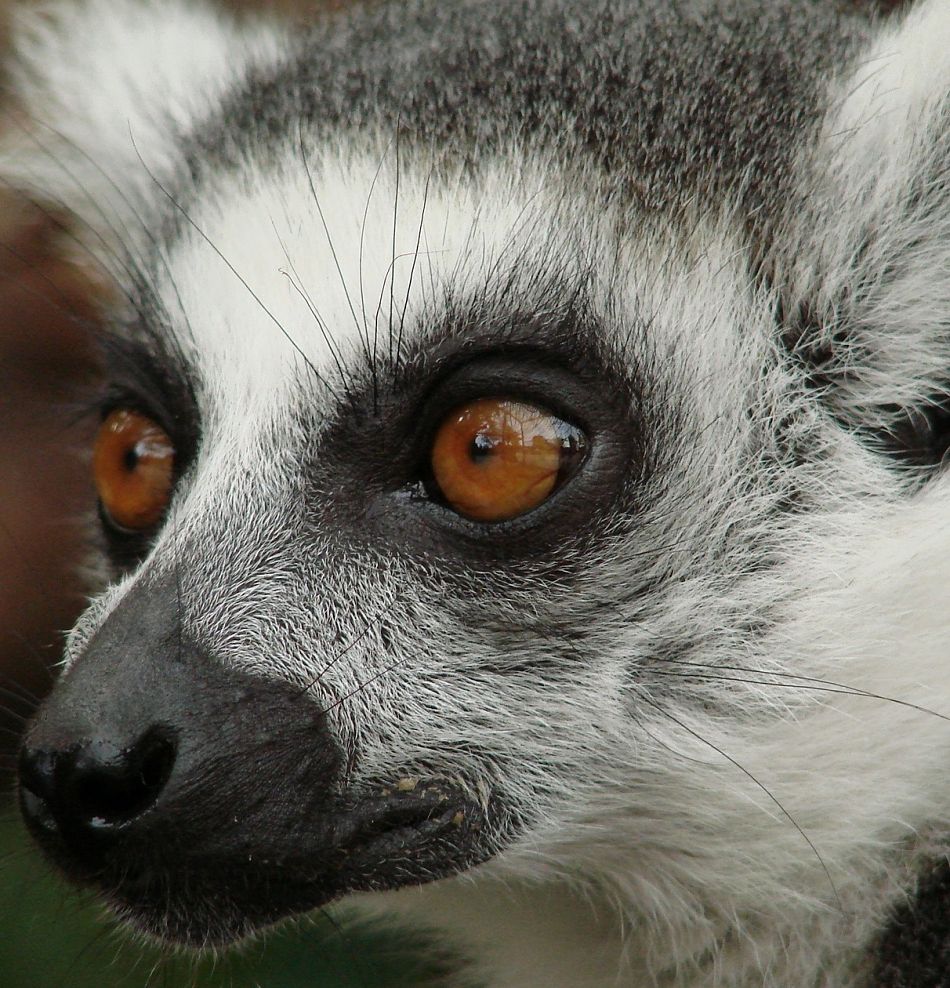lemur Facts
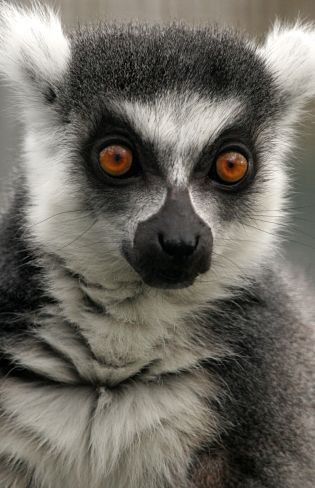 Portrait of a Lemur
Portrait of a LemurOne of the coolest lemur facts is that they can easily jump 6 times their body length. Lemurs are woolly-furred, long-tailed, arboreal animals that are found only on the island of Madagascar off the Eastern coast of Africa.
There are more than 30 different species and dozens of subspecies of lemurs, ranging in size from the 1 ounce mouse lemur, to the 20 pound Indri.
These creatures evolved undisturbed in an isolated environment for millions of years, and thrived in their island paradise until human beings came to Madagascar about 2000 years ago. Since then, people have destroyed over 90 percent of the natural forests, leaving the lemurs, as a group, the most endangered mammals in the world.
Most lemurs are plant eaters that indulge in the tropical leaves, fruits, shoots and flowers of the island, while occasionally dining on insects, and possibly small reptiles and birds.
They are social, active animals with remarkable athletic abilities, who can leap 30 feet or more from limb to limb using their powerful, long legs and strong gripping hands and feet. The long, thickly furred tail is not prehensile, but acts like a rudder as they fly through the air, and a signalling device while on the ground.
Some species, such as the large, exquisitely black-furred Indri, are almost exclusively tree-dwelling, while the most recognizable species, the beautiful ring-tailed lemur, spends as much as 70 percent of the time on the ground, even sleeping in big, furry, communal, heaps, right out in the open on grass or rocks.
Ring-tail lemurs are small animals, overall, at about 5 or 6 pounds fully grown, but they live in alert communities of 10 to 25 individuals, and use warning calls if danger approaches.

A group of lemurs is called a conspiracy, and they will, in fact, conspire together against predators, occasionally using a technique called "mobbing", where the entire group will attack. This is seen most often against snakes, where families of lemurs will converge on a large ground boa and simply beat it to death.
Only Madagascar's largest predator, the awesome fossa, which looks like a small, brown, 25 pound mountain lion, but is actually related to the mongoose, regularly preys on ring-tailed lemurs, although buzzards, large boas, and domestic dogs are also an occasional threat.
Hunting has only recently become an issue, as some of the old customs and traditions of Madagascar change with the times. Lemurs were once considered a sacred animal that was honored and respected. The people believed that harming a lemur in any way would bring bad luck, disease, or even death. But the taboo has eroded, and in the last decade, people have been hunting lemurs for their meat and fur, and lemur dishes are served in local taverns, despite being illegal.
But the biggest danger for lemurs is deforestation. With a new president elected in 2014, the government of Madagascar announced a new initiative to save their most iconic citizens. Madagascar's unique wildlife, if preserved wisely, can help the nations ecotourism trade blossom, and with over 200,000 tourists per year and growing, the thousands of species of plants, reptiles, and of course, lemurs, exclusive to this one island, must somehow survive.
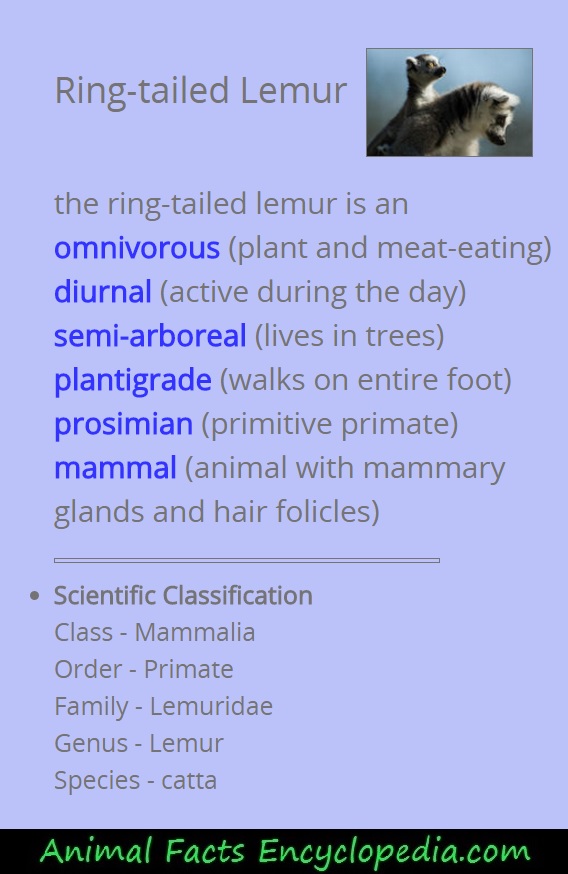
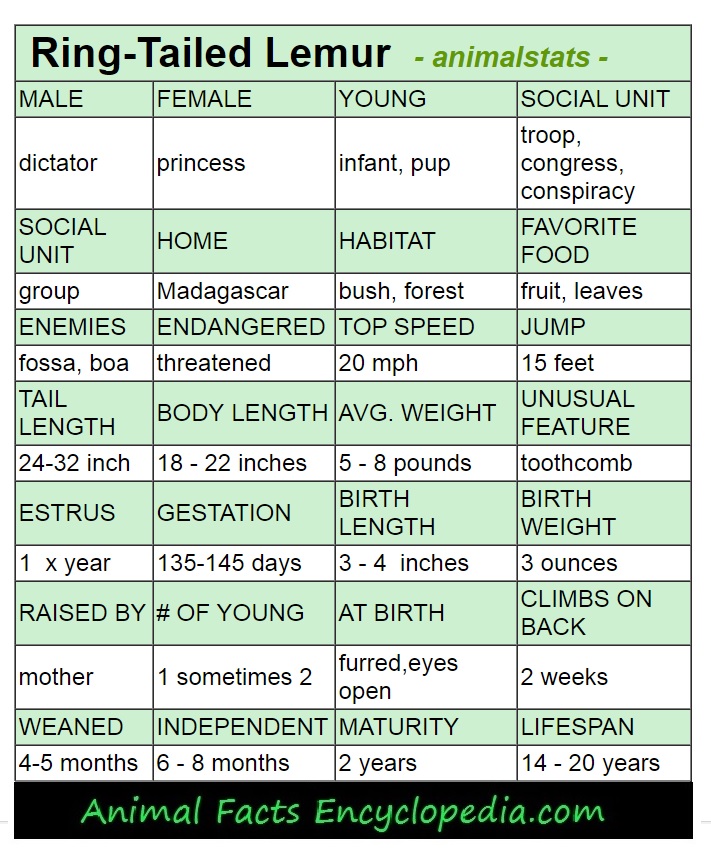

are lemurs monkeys?
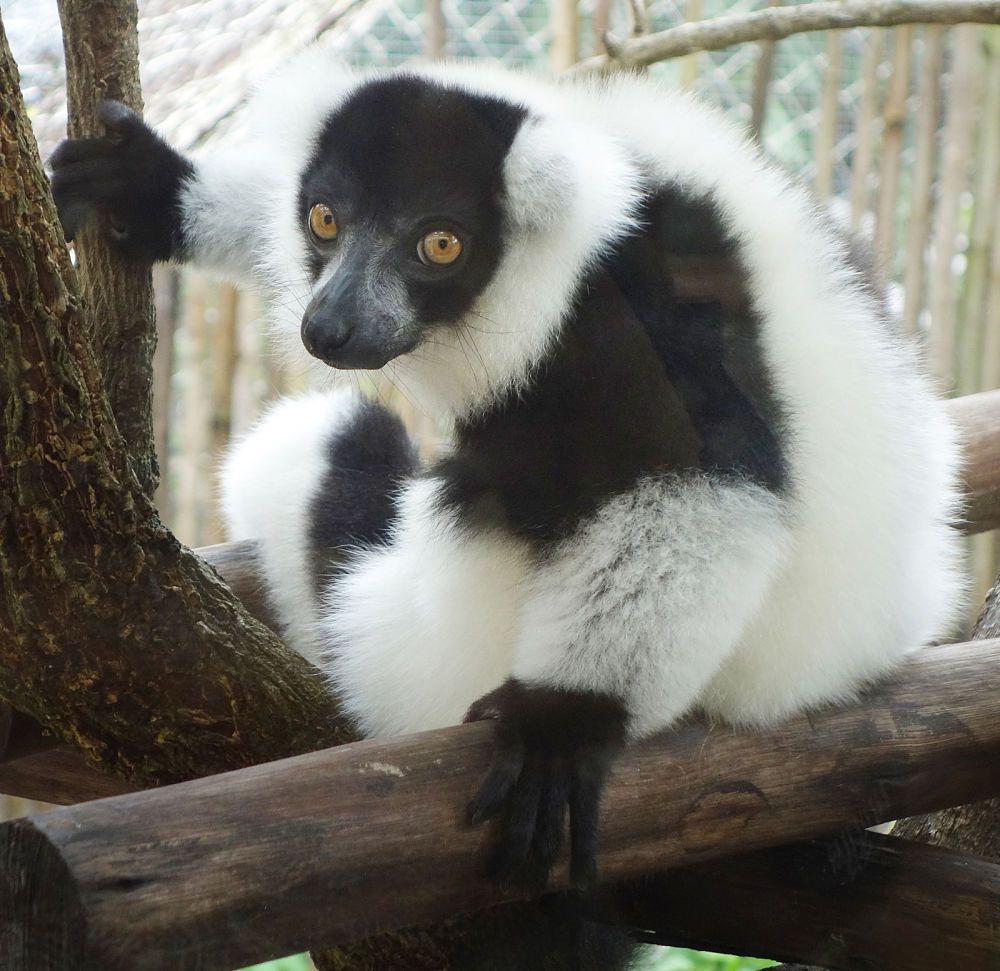 white-ruffed lemur
white-ruffed lemur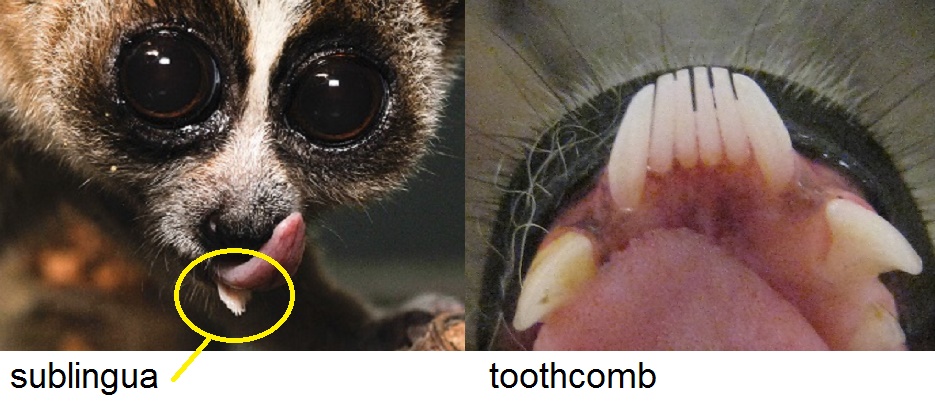
Primates are broken into 2 groups, wet-nosed primates like lemurs, lorises, and galagos, and dry-nosed primates like monkeys and apes. (including us).
The wet-nosed primates are called prosimians, because they evolved separately from, and millions of years before the monkeys. In fact, the word prosimian literally means "before monkeys".
The differences between monkeys and prosimians goes beyond the wet, dog-like noses that lemurs and lorises have.
Prosimians don't have the flexible, expressive faces of monkeys, and their eyes and orbital sockets are angled differently from monkeys, with a little more emphasis on peripheral vision, and less on stereoscopic focus.
More of the prosimian brain is dedicated to the sense of smell, than to the sense of sight, not surprising, since the dog-like, wet nose is extremely adept.
And prosimians have two very unique features, the tooth comb and the toilet claw, that monkeys lack.
The toothcomb is a specialization of the front teeth in the lower jaw. These teeth are long, slender, and perfectly parellel with narrow, even spaces between them. They project horizontally from the mandible, and are used in grooming the fur, just like a barber's comb.
The most unusual part of this adaption is the sublingua, or "under tongue". It is a small, serrated, secondary structure beneath the tongue, but it doesn't have taste buds or salivary glands, it is specifically designed to clean the toothcomb.
In the case of lemurs, the "toilet claw" refers to the second toe of the foot, which has a claw, rather than the usual nail, and is used primarily for scratching an itch. The digit that has this adaption, varies among the prosimians, but monkeys do not have this anatomical feature. - Lemur Facts
lemur lifestyle
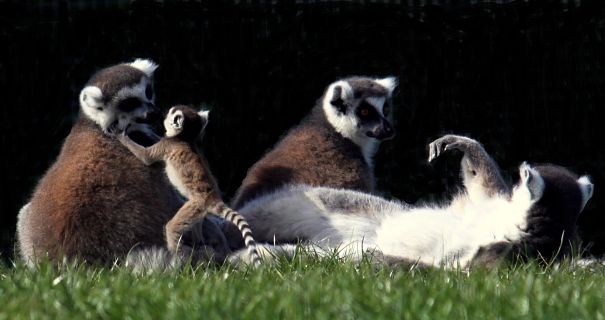
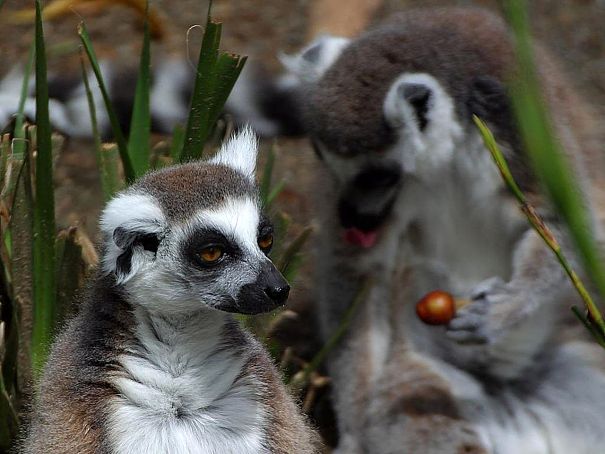
Some lemurs are almost completely arboreal, and able to live the majority of their lives off the ground, high in the trees. Nocturnal lemurs like the aye-aye are mostly solitary animals, while diurnal species like the Indri and Sifaka are very social, living in groups and communicating with numerous calls.
These animals are incredibly athletic, and employ a vertical position while climbing. They leap from tree to tree by thrusting against the tree trunk with their long, powerful, frog-like legs that unfold like springs to launch them as far as 30 feet in a single bound. But they come down to the ground in the morning hours to sun themselves, sitting like little Buddhas, hands on their knees, palms up, with their bellies and chests exposed to the warmth.
One of the most familiar lemurs is the ring-tailed lemur. The ring-tailed is in it's own genus, differing from other lemur species in a number of ways. They spend more time on the ground than any other species - up to 80% of the time, depending upon their habitat. They are quadrupedal, walking and running on all-fours just like dogs, but will occasionally take a few steps on their hind legs.
Although they eat mostly leaves and fruits found in trees and shrubs, they are the only lemurs that occasionally feed on the ground, and will actually lower their heads like cows to graze on leafy plants and mosses. They live in the largest groups, with 30 or more individuals in a troop, although 12 to 20 is most common.
Ring-tailed lemurs are extremely expressive and vocal animals, with approximately 28 separate calls. They bleat like baby lambs, purr like cats, click and croak like frogs, they make high wails and loud whoops, and regularly engage in group vocalizations, like a pack of wolves howling together.
They are also the only lemurs with rings on their tails, an adaption that reflects their more terrestrial lifestyle. The highly visible black rings, usually 13 or 14 on a tail, and always with a black tip, help them keep together, track one another and judge each others moods.
The tail plays a big part in their lives. About 15% longer than the lemurs entire body, it is held straight up vertically as they walk, the tip sometimes curled over. Tails wave gracefully like feathers when all is calm, but straighten out tense, hairs on end, like a frightened cat tail during moments of conflict.
The tail is not prehensile, but it is expressive, even used as an exhibit of aggression known as a "stink fight". The stink fight is a ritualistic battle where males will rub their tails against scent glands on their chests and wrists, and then wave them at each other, projecting their special smell. They will even do handstands thrusting their tails over their heads for impact. It's not really clear how the winner is decided.
Ring-tailed lemurs have a matriarchal society, with a fairly clear order of dominance that is established and maintained by mildly aggressive behaviors like staring, lunging, and pushing. Females are dominant over males, and one mature female is usually in charge, deciding when the group travels, eats or rests.
Even the lowest ranked female is dominant over all the males in the group. If there is unrest between two neighboring groups of ring-tails, the females will engage each other, not the males, but conflicts are rarely serious.
During their lives, females stay with the group they were born into, while males will leave and integrate into neighboring groups when they are 3 to 5 years old.
Male ring-tailed lemurs have scent glands on their chest, rumps and wrists. The wrist glands have a spur-like fingernail that is known as the horny spur. They will use this spur to rake at the trunks of sapling trees with their wrists leaving a gash in the tree that is filled with their scent. This is both a visual and olfactory marking of territory.
Lemurs have opposable thumbs and big toes, but they don't display any tool use in the wild, and don't usually handle or play with inanimate objects as monkeys do. During research experiments using touch screens, they do not use their fingers as monkeys do, instead touching the screen with their noses.
Still, lemurs at the Duke University primate center have displayed the ability to learn tool use, solve intricate problems and to discriminate quantities - in effect, to count. - Lemur Facts
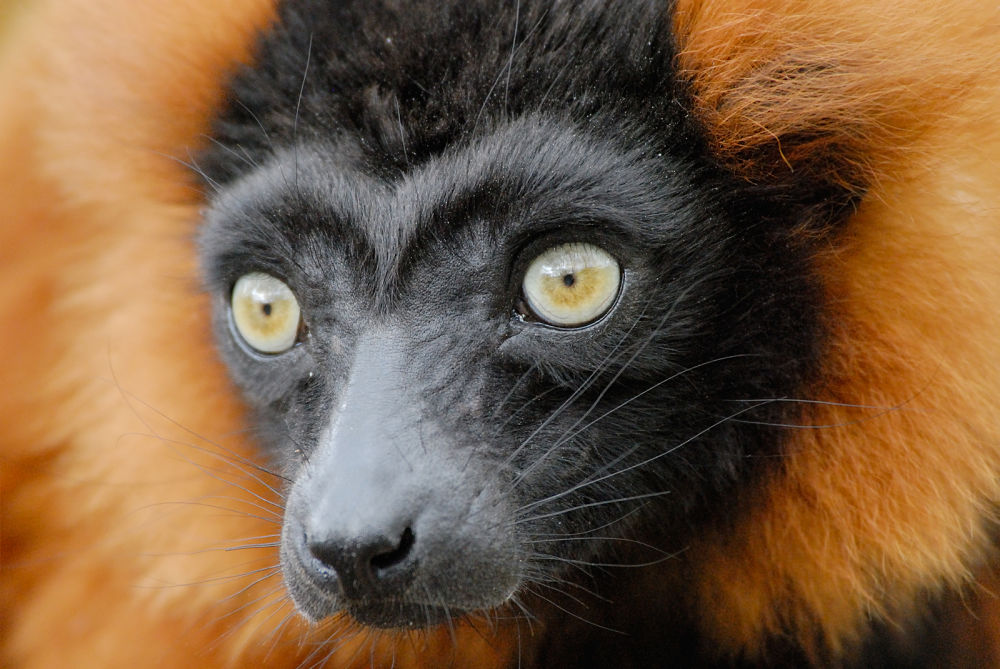 Red-ruffed Lemur
Red-ruffed Lemurlemur reproduction
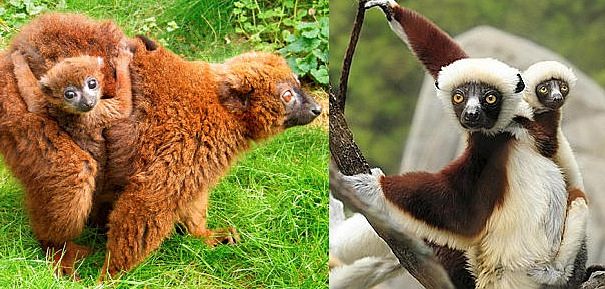 lemur babies
lemur babies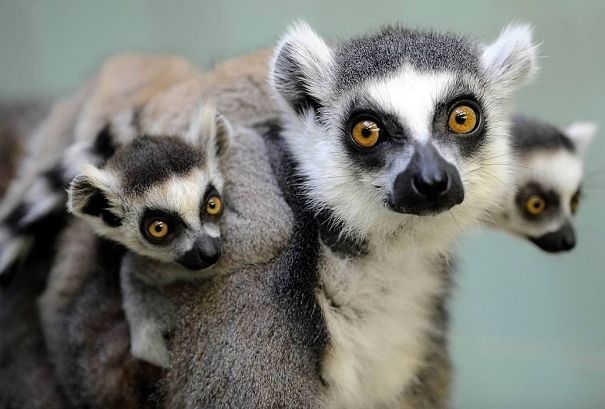 ring-tailed lemur mother and babies
ring-tailed lemur mother and babiesFemale ring-tailed lemurs come into season once a year, for only about 24 hours, during which she may mate with multiple partners. The ring-tailed lemurs mating season is from late April to early June, which means births coincide with the beginning of the rainy season, sometime between August and September. This insures that nursing mothers will have plenty of food sources to carry them through the stress of rearing youngsters.
Female lemurs have anal scent glands that indicate when they are in season. The male lemur has special scent glands on his chest and wrists that release a chemical blueprint of his health and fitness. He pulls his tail against his chest and rubs these glands against it, and then waves his tail in the females direction, luring her with his odor. Males will wave their tails at each other too, in mock battles called "stink fights".
Females ring-tails are pregnant for 135 to 145 days, and give birth to one, or sometimes two infants. The newborn lemur has thick fur, open eyes and a clasping instinct that gives it the ability to cling to it's mothers chest just moments after birth.
Babies will travel underneath their mother, sometimes held by her, but capable of staying on all by themselves, for 2 weeks, and then they start migrating to her back, where they will ride like a tiny jockey, and cling on tight as she flies through the forest.
Once the baby lemur has reached about three weeks old, it will start to venture off it's mother's back, just for brief moments, and then hop right back on.
Both male and female adults in the troop interact with infants, and may babysit briefly as the mother rests or forages. If a baby is orphaned, the troop will take over it's care, and another nursing mother may adopt it.
Because lemur reproduction is strictly seasonal, all the babies are born at the same time of year, between late August and early September, and grow up together.
By six weeks or so, they are playing together in excited little nursery groups, cuddling, wrestling and bouncing through the trees. They are weaned at 8 to 10 weeks, and stop riding on their mother's backs after 12 to 14 weeks.
The youngsters are independent by eight months, but stay close to their mothers. Females will remain with the same troop for life, while young males will move to other troops at 3 to 5 years old, and may switch groups every few years. This insures genetic diversity within the species. - Lemur Facts
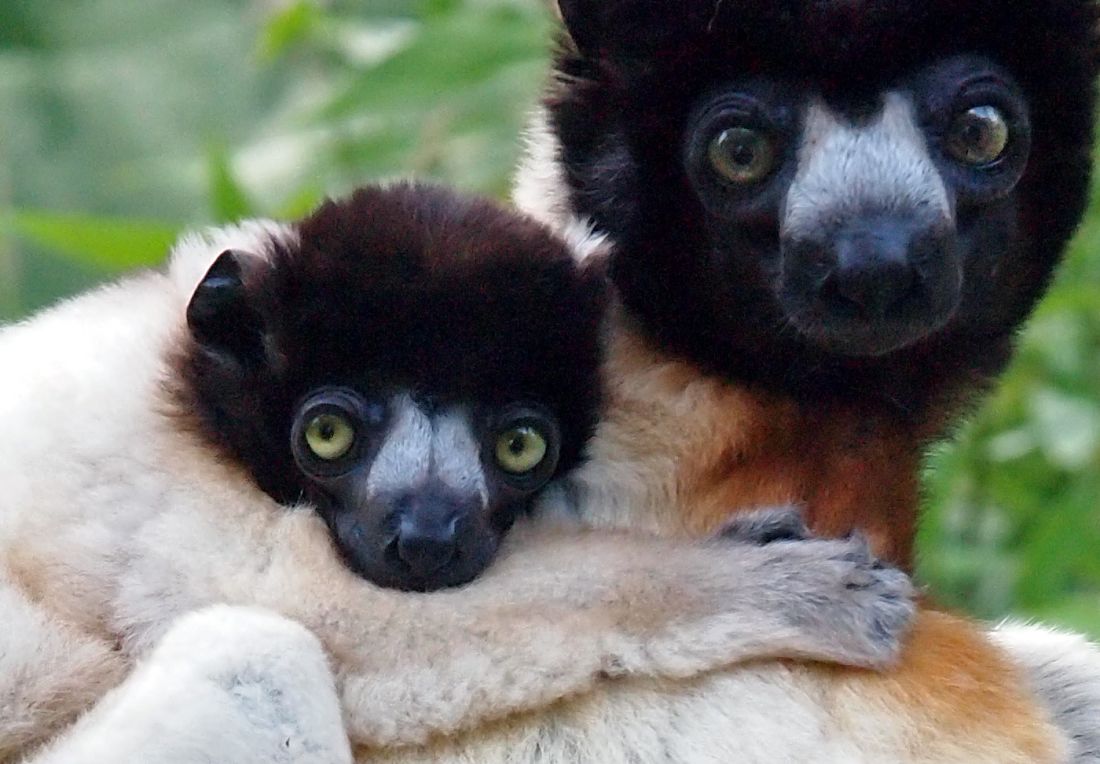 Crowned Sifaka mother and infant
Crowned Sifaka mother and infant
lemur species
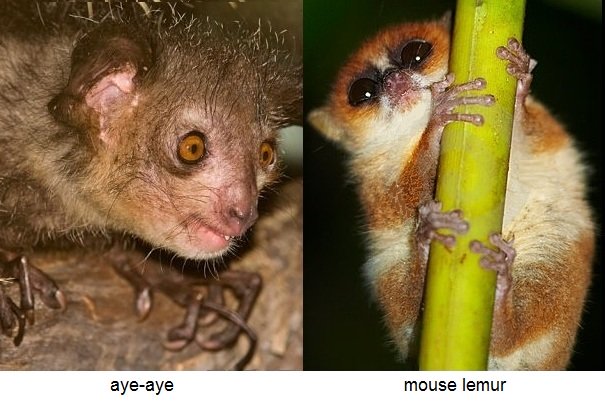
There are about 30 species of lemurs, with dozens of subspecies classified, but this number has changed often in recent years, as numerous subspecies have been given their own species status.
A species can gain more protections by governments and wildlife organizations than a subspecies, and because the survival of all lemurs in the wild is in danger, conservationists desire to recognize small imperiled populations as actual unique species, which has caused the increase.
Simply put, some politics has affected the scientific process, but the end fight is to save these wonderful animals.
The pygmy mouse lemur is the smallest species. This tiny, wide-eyed creature is the tinyest living primate at only 5 inches from head to tail. Mouse lemurs are nocturnal, and feed mainly on insects. They hunt at night, using their incredible night vision and powerful sense of smell, plucking insects from tree limbs, and rustling through undergrowth for beetles and grubs.
The aye-aye is a startling and strange looking animal, with rough-textured, shaggy grey fur, huge eyes and ears, and curious specialized fingers. Like nocturnal woodpeckers, they use their long bony finger to tap on branches, locating grubs under the bark and spearing them out with their specialized claws. Aye-ayes make large nests in the crooks of trees and sleep all day, out of the suns glare.
The Indri is the largest lemur species at up to 25 pounds. They are called "Babakoto" which means "little father", because the locals believe they are our direct ancestor. Indi live in small groups of 6 to 12 individuals, who routinely call across the forest to each other with loud, eerie, whale-like sounds.
Finally, nine species of lemurs known as sifakas, are iconic creatures in Madagascar. They have beautiful coats of contrasting colors, and are famous for their hopping gate.
Amazing climbers and incredible leapers, the sifakas have slender, elongated limbs and torso. They bounce effortlessly through the woods, pushing off tree trunks with their long, frog-like back legs, like little Parkour runners.
But when they come down to the ground to sun themselves, and to move between tree groves, or cross man-made obstacles like roads and railroad tracks, they hop along on their hind legs in big, sideways bounds, their hands held out wide for balance. It looks like a dance of joy, and certainly is delightful to watch. - Amazing!
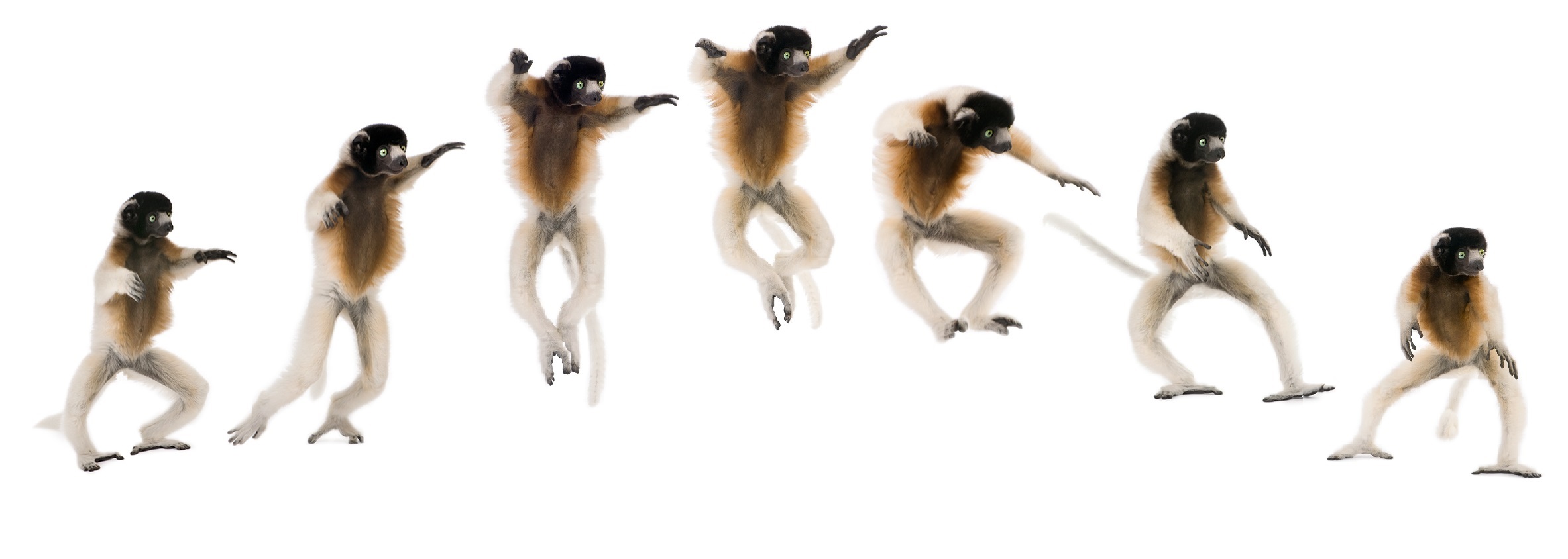 how does the sifaka cross the road?
how does the sifaka cross the road?a few more lemur facts
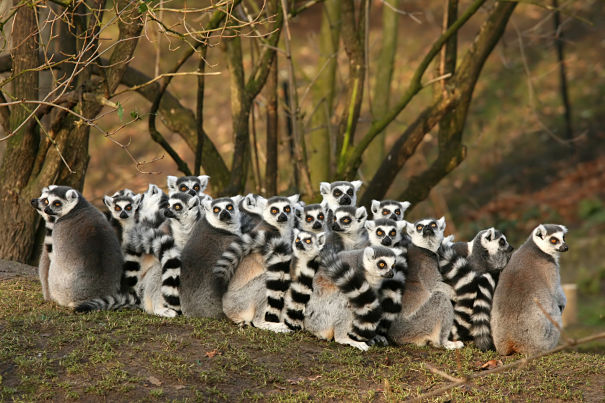
- Lemurs are only found on the island of Madagascar and tiny neighboring Comoro islands
- Lemurs are primates, but they are not monkeys
- Lemurs have lower front teeth that are fashioned into a comb for grooming
- Ring-tailed lemurs spend the most time on the ground
- The aye-aye has a special, long, boney finger, for hunting insects
- Natives believed whoever the aye-aye pointed its finger at was doomed
- The lemur has a wet nose, like a dog, and a great sense of smell
- Scientists think lemur ancestors drifted to the island of Madagascar on clumps of floating vegetation
see more animal extreme closeups
Recent Articles
-
African Animals - Animal Facts Encyclopedia
Oct 11, 16 10:27 PM
African Animals facts photos and videos..Africa is a wonderland for animal lovers, and a schoolroom for anyone who wants to learn about nature, beauty and the rhythm of life -
Baboon Facts - Animal Facts Encyclopedia
Oct 11, 16 10:26 PM
Baboon facts, photos, videos and information - Baboons are very distinctive looking monkeys with long, dog-like snouts and close set eyes. -
Great Apes Facts - Animal Facts Encyclopedia
Oct 11, 16 10:25 PM
Great apes facts, photos and videos..Human beings did not evolve from chimpanzees, modern chimps and gorillas do not appear in the fossil records until much more recently than homo sapiens..






















